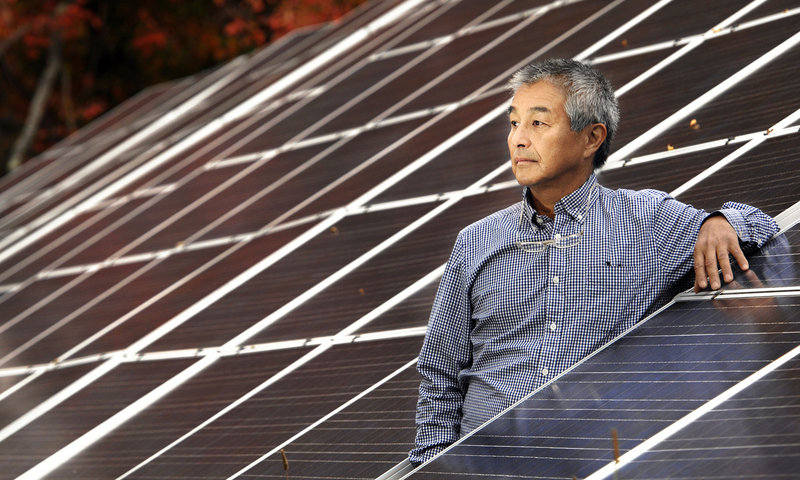HARTFORD, Conn. — Dmitri Donskoy figures he’ll save only $20 a month on his electricity bill after solar panels are installed on the roof of his home under a state-subsidized program. But he shrugs it off because the green energy appeals to his environmental concerns.
Donskoy, a software developer in Prospect, said he was motivated to go solar after Connecticut officials killed a wind turbine proposed for the town last year.
“It was partly sparked by my annoyance of the cancellation of the windmill project,” he said. “There must be a way for us to contribute.”
Installing solar panels could cost, on average, $35,000, according to a state energy agency spokesman. Donskoy says he’s leasing because he doesn’t have thousands of dollars to spend, instead paying a solar company $58 a month for his electricity.
“The savings didn’t motivate me. It’s really the environmental aspects,” Donskoy said.
Solar energy is seen as one way to save in Connecticut, where residential electricity costs were the third highest in the United States in 2010, exceeded only by Hawaii and New York, according to the U.S. Department of Energy. Solar represents a fraction of the state’s overall energy supply, but backers hope it will grow.
Connecticut ratepayers are subsidizing a state solar power initiative that has spent $2.5 million to install rooftop solar panels for 209 homes. At least one solar energy company has set up shop in Connecticut to scout for business.
On Friday, the Clean Energy Finance and Investment Authority announced it will spend $10 million for 5.6 megawatts of additional residential solar panels. Spokesman David Goldberg, said state subsidies represent about one-third of the total cost of solar panel installations. Homeowners and businesses pay $4.3 million to install or lease solar panels.
The goal is to generate up to 30 megawatts of residential solar power in 10 years — with a potential cost of $90 million. Goldberg says backers believe that can be achieved sooner.
“The whole game is to leverage as much as possible,” Goldberg said.
The state program provides an average of one-fourth to one-third the cost of residential rooftop solar panel installations, he said. With federal tax credits covering another 20 percent, the average $35,000 bill could be cut in half, Goldberg said.
Donskoy’s system, which provides one-third of his electricity use, is typical.
Most homeowners want a system that displaces all their electrical use, said Mike Trahan, executive director of Solar Connecticut, an industry group. But that’s rarely possible because of how much roof space that would require, the amount of shade and other factors, he said.
More typically, a solar system can displace as much as 70 percent of their electric bills, Trahan said. Homeowners can expect a return on their investment in 10 years, he said.
Systems such as Donskoy’s can be leased for no money down, Trahan said, with various payment arrangements.
Connecticut is one of 13 states along with Washington, D.C., and Puerto Rico that offers rebates for solar installations. In Maine, residential or commercial owners and tenants receive $500 for each 1,000 kilowatt hours produced, up to $2,000 for residences and $4,000 for commercial use, the Energy Department says.
Rebates of up to $4,250 are paid in Massachusetts for residential solar use.
Federal tax credits also are available.
The cost of domestically produced solar panels has plummeted because of Chinese competition.
While manufacturers may be struggling, installers are flourishing because prices are so low, said Philip Jordan, chief business officer at BW Research Partnership, an economic development and market research firm.
In states where electricity is costly, subsidies are greater and more solar panels are being installed, he said. That fits the pattern for Connecticut as lawmakers and Gov. Dannel P. Malloy enacted the energy legislation last year in response to complaints that energy deregulation in the late 1990s fell short and did little to keep electricity rates down.
The clean energy fund was one of several changes in state energy policy that also merged two agencies and brought the state into the purchase of power with Connecticut’s two major utilities.
Glenn Martin, owner of GM Industries, a Tolland manufacturer of heating, cooling and solar tracking equipment, said his company is benefiting from the state program because it allows consumers to spend less of their own money.
“The weak economy is having an effect on all businesses, but we are busy,” he said.
Use of solar energy in the U.S. has risen significantly, from 0.7 percent to 2.5 percent over the last few years, but still represents a small percentage of overall energy sources, Jordan said. Utilities choose from among hydroelectric power, coal and natural gas to run power plants, but incentives could eventually stimulate enough solar power to make a difference, Jordan said.
That appeals to Donskoy’s environmental concerns after the Connecticut Siting Council rejected a proposed wind power project in Prospect last year, citing the visual impact.
“My own personal philosophy is to tread as lightly as I can,” he said.
Send questions/comments to the editors.



Success. Please wait for the page to reload. If the page does not reload within 5 seconds, please refresh the page.
Enter your email and password to access comments.
Hi, to comment on stories you must . This profile is in addition to your subscription and website login.
Already have a commenting profile? .
Invalid username/password.
Please check your email to confirm and complete your registration.
Only subscribers are eligible to post comments. Please subscribe or login first for digital access. Here’s why.
Use the form below to reset your password. When you've submitted your account email, we will send an email with a reset code.